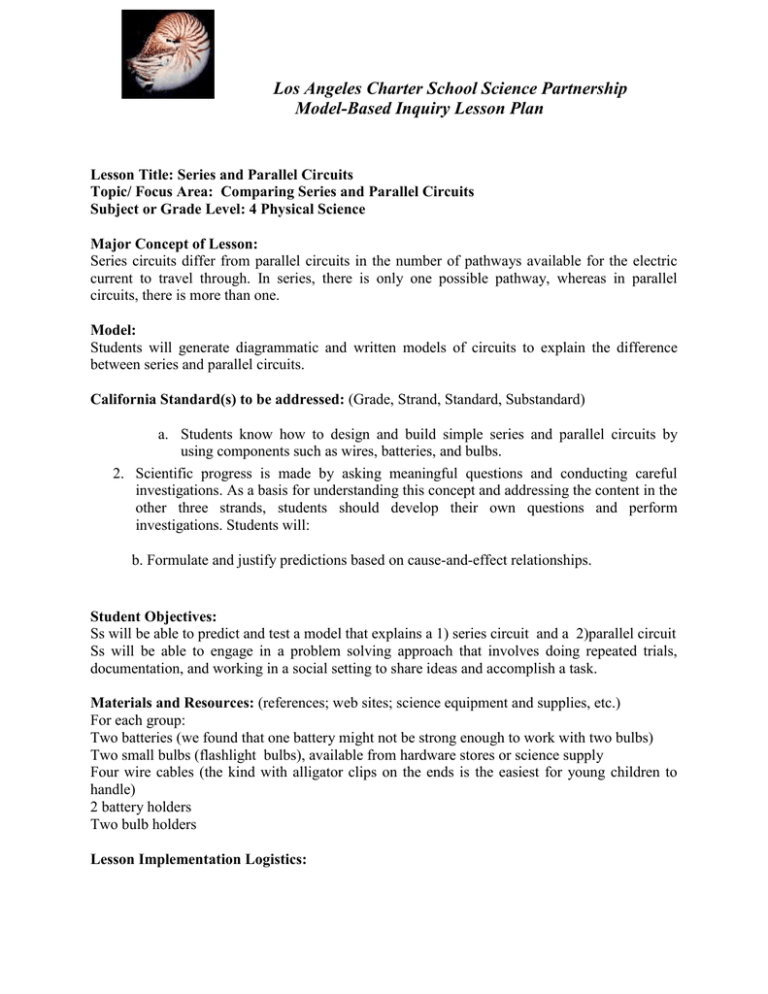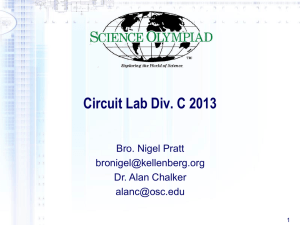Series and Parallel Circuits Lesson Plan
advertisement

Los Angeles Charter School Science Partnership Model-Based Inquiry Lesson Plan Lesson Title: Series and Parallel Circuits Topic/ Focus Area: Comparing Series and Parallel Circuits Subject or Grade Level: 4 Physical Science Major Concept of Lesson: Series circuits differ from parallel circuits in the number of pathways available for the electric current to travel through. In series, there is only one possible pathway, whereas in parallel circuits, there is more than one. Model: Students will generate diagrammatic and written models of circuits to explain the difference between series and parallel circuits. California Standard(s) to be addressed: (Grade, Strand, Standard, Substandard) a. Students know how to design and build simple series and parallel circuits by using components such as wires, batteries, and bulbs. 2. Scientific progress is made by asking meaningful questions and conducting careful investigations. As a basis for understanding this concept and addressing the content in the other three strands, students should develop their own questions and perform investigations. Students will: b. Formulate and justify predictions based on cause-and-effect relationships. Student Objectives: Ss will be able to predict and test a model that explains a 1) series circuit and a 2)parallel circuit Ss will be able to engage in a problem solving approach that involves doing repeated trials, documentation, and working in a social setting to share ideas and accomplish a task. Materials and Resources: (references; web sites; science equipment and supplies, etc.) For each group: Two batteries (we found that one battery might not be strong enough to work with two bulbs) Two small bulbs (flashlight bulbs), available from hardware stores or science supply Four wire cables (the kind with alligator clips on the ends is the easiest for young children to handle) 2 battery holders Two bulb holders Lesson Implementation Logistics: This lesson focuses only on series and parallel circuits. We agreed that the lesson prior to this one should address simple circuits, in which students try to light a bulb using a battery, one wire, and bulb. Students should be given time to develop their models of this simple circuit (diagrams with written explanation), and the teacher should introduce the movement of electric current through the circuit, the role of a switch (open and closed circuits), and relevant vocabulary (source, conductor, insulator, switch, resistor, bulb filament, electricity, electric current, load, positive and negative charge, contact, etc). The teacher could also reinforce the concepts through the use of other models (teacher or student-generated) such as TPR, that is, having Ss act out an electric current, or using pictorial diagrams (e.g. the Magic School bus going through a current). Teacher should test all bulbs and batteries before the activity to make sure they all work well. Also, make sure that Ss know there should be good battery-to-wire and battery-to-battery contact. Steps of the Lesson Learning Activities which lead to Model: Teacher Questions for Activity: Key questions that show progression from lower to higher order thinking. Anticipated Student Responses, Questions and Errors: T: What is happening? How is this similar to the simple circuits you built in the last lesson? S: The electricity is flowing through all of us. ENGAGE UFO Ball Activity: All Ss and T stand around the classroom in a large circle, holding hands or contacting each other. Teacher holds UFO ball from one of the contact points and has a S hold the other contact point on the ball. Wait for current to travel around circle and reach ball, at which point ball should light up. T: What happens if S: There will Ask: What is happening here? How is this similar to the we break arms? be a gap and simple circuits you built in the last lesson? the lights will go off and To get Ss to wonder, but without explaining “series and the sound parallel”, use two balls and get both to light up. Then will stop. remove one and see what happens to the other ball. Teacher Response to Students and Teacher Intervention Activities or Strategies What is happening here? Accept answers but do not T: Where does the discuss too much at this point. electricity come from? (Optional)Then use two balls, forming a parallel circuit, and get one to stay lit when the other is taken away. Ask What is happening here? Again, accept answers but do not discuss much. S: The electricity came from the inside the ball and flows through each of us. T: What produced the electricity inside the ball? S: That one represents a battery S: The wavy line represents a wire S: The square represents the battery clip S: The circle represents a light bulb stand S: That symbol represents the unlit bulb S: That symbol represents the lighted bulb. The teacher will monitor and see if students are using the symbols provided in their worksheets. EXPLORE Discovering the Difference Between Series and ParallelCircuits-Students will do an inquiry based activity in which they create a series and parallel circuit one at a time. 1. T explains the Trials Log Worksheet for Series Circuit first. (Do not pass out materials yet.) T lists materials that will be given to each group and reviews symbols and what they represent.. Symbols can be projected or posted T: What do you on board. think these symbols represent? 2. Initial Model: Working in pairs, partner 1 will draw a diagram under trial 1. 3. T hands out materials. Partner 2 works with partner 1 to test the prediction, and records “yes” if the circuit worked or “no” if it did not. 4. If it did not work, partner 2 will diagram a circuit and assist partner 1 in building it. Continue in this fashion until the partner group is successful. 5. Revised Models: T passes out Electric Circuit Model Worksheet and Ss work together to complete it (diagram model and explanation.) ONE STUDENT MUST COMPLETE THE DIAGRAM AND THE OTHER STUDENT THE EXPLANATION. ENCOURAGE Ss TO TALK TO ONE ANOTHER AND SHARE IDEAS. Ss discuss: How is this circuit different from our initial ideas (initial model)? What have we learned? 5. Be sure Ss use accurate labeling and use of arrows to show directionality. 6. T now distributes additional supplies for the parallel circuit. Ss repeat steps 1-3 (i.e. pass out the Trials Log Worksheet for Parallel Circuit now, etc.) T: Review symbols 7. NOTE: For #5 on the Electric Circuit Model with the student Worksheet, Ss should use vocabulary words from the posted Word List. EXPLAIN A. Student Explanation: 1. Teacher selects pairs of Ss to share their Electric Circuits Model Worksheets with the rest of the class, preferably using an ELMO/Doc Projector. Students explain their revised models in which they describe where the electricity travels in both the series and parallel circuits. What is the difference between the way electricity travels in the two circuits you have created? Talk to your partner first before writing. More importantly, students will also explain # 5, in which they compare the two circuits! B. Teacher Explanation: T uses “Lesson 11” sheet to explain and summarize the two circuits. Clear up misconceptions and model the use of the vocabulary. Be sure to explain the current flow in step by step fashion, using the same starting point as Ss. ELABORATE Four Scenarios: - Scenario: My whole strand of Christmas lights has gone out. Why? - Scenario: One of the lights on my strand of Christmas lights is broken, but the rest of the strand still turns on. Why? - Scenario: You turn on the light switch to your room, but the lights do not turn on. Why? - Scenario: My flashlight won’t work. Why? EVALUATE Ss will be given time to redraw and rewrite their models and explanations (Electric Circuits Models Worksheets). T will evaluate these revised models/explanations. -Will all strands of Christmas lights go out, or are there different types? -What would cause some of the lights to light up while the others remain on? -Is there a way to test where the circuit has been broken? -What type of circuit makes up a flashlight? -How can you determine the cause of an inoperable flashlight? The difference is that in a parallel circuit, the electric circuit can follow more than one path. This is why the 2nd bulb stays lit, because electricity can still get to it. -Students may link the issue to an unplugged strand or a broken bulb. -Students may question the parallel circuitry of the strand (may not be able to visualize how parallel circuits can be formed in such a small space. If Ss do not understand parallel circuits, T can demonstrate using the two UFO balls again. Have a strand of Christmas lights and a flashlight available. Have a diagram of the circuitry of a house. Students who have difficulty understanding how a circuit works can continue to manipulate the components Where is the until they battery? Is it understand. in the wall?






